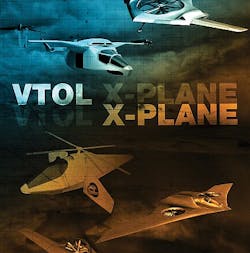Sikorsky, Aurora Flight Sciences face off on DARPA VTOL X-Plane advanced tiltrotor project
ARLINGTON, Va., 15 Dec. 2013. Engineers from two U.S. aeronautics companies are starting to develop a high-speed vertical takeoff-and-landing (VTOL) aircraft with the hover capability of a helicopter that can fly nearly 50 percent faster than the Boeing V-22 Osprey tiltrotor aircraft.
Sikorsky Aircraft Corp. in Stratford, Conn., and Aurora Flight Sciences in Manassas, Va., have won contracts for the initial phase of the Vertical Take-Off and Landing Experimental Plane (VTOL X-Plane) project of the U.S. Defense Advanced Research Projects Agency (DARPA) in Arlington, Va.
Sikorsky won a $14.4 million contract last month, and Aurora Flight Sciences won a $14 million contract this past week for the first phase of the DARPA VTOL X-Plane program -- a four-year $130 million effort to fly an experimental aircraft that flies faster than 300 knots with a hover efficiency of 75 percent or better and a cruise lift-to-drag ratio of 10 or more.
During Phase 1, Sikorsky and Aurora Flight Sciences will conduct trade studies and develop the VTOL X-Plane's initial design. Sikorsky is teaming with the Lockheed Martin Corp. Skunk Works in Palmdale, Calif., for the VTOL X-Plane development.
The Boeing V-22 Osprey tiltrotor is one of the first VTOL aircraft deployed with U.S. forces. It has a top speed of 275 knots. The DARPA VTOL X-Plane project has a goal of increasing VTOL aircraft speed to at least 400 knots -- or about the cruise speed of small business jets.
The VTOL X-Plane program seeks to achieve its speed goals through cross-pollination between the fixed-wing and rotary-wing worlds to achieve radical improvements in VTOL flight, DARPA officials say.
Sikorsky and Aurora Flight Sciences engineers will design hybrid aircraft that will push VTOL limits in speed, hover efficiency, cruise efficiency, and useful load.
The VTOL X-Plane project is aiming at a top sustained flight speed of 300 to 400 knots; hover efficiency of at least 75 percent; cruise efficiency lift-to-drag ratio of at least 10; and useful load capacity of at least 40 percent of the vehicle’s projected gross weight of 10,000 to 12,000 pounds.
The VTOL X-Plane program is scheduled for three phases over 52 months between October 2013 and February 2018, with the first demonstration flight set for spring 2017.
DARPA has allotted $47 million in Phase I, so more contracts could be awarded for preliminary concept design and technology maturation. Ultimately DARPA officials will downselect to one of the Phase I contractors to move forward with the second and third phases of the program.
The second phase of the DARPA VTOL X-Plane program will involve design, development, and integration, and the third phase will involve flight-test demonstrations.
For more information contact Sikorsky Aircraft online at www.sikorsky.com, Aurora Flight Sciences at www.aurora.aero, or DARPA at www.darpa.mil.

